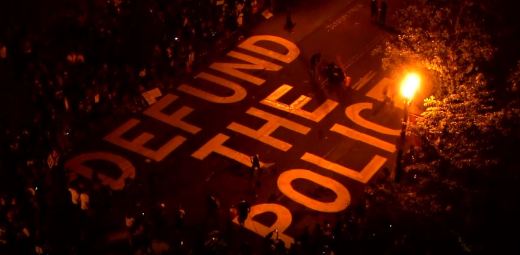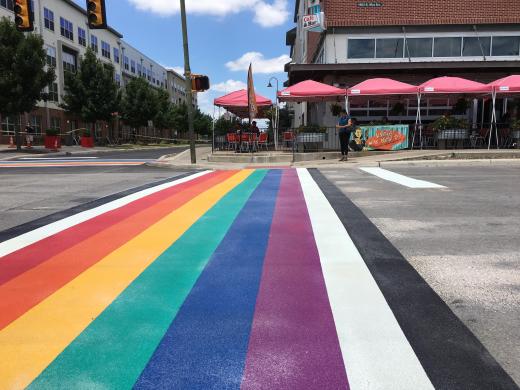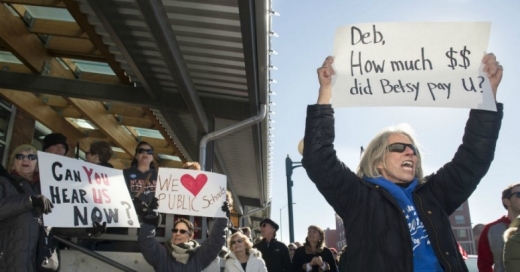
There is a Cherokee proverb that features a grandfather speaking to his grandson:
“A fight is going on inside me,” he said to the boy.
“It is a terrible fight and it is between two wolves. One is evil; he is anger, envy, sorrow, regret, greed, arrogance, self-pity, guilt, resentment, inferiority, lies, false pride, superiority, and ego.”
He continued, “The other is good; he is joy, peace, love, hope, serenity, humility, kindness, benevolence, empathy, generosity, truth, compassion, and faith. The same fight is going on inside you and inside every other person, too.”
The grandson thought about it for a minute and then asked his grandfather: “Which wolf will win?”
The grandfather replied, “The one you feed.”
To transform toxic systems—systems that devour Black, Brown, and Indigenous bodies, systems that cannibalize communities, systems such as policing that gorge on not only public dollars but also the spines of the very people they are supposed to protect and serve—to transform these systems, you have to starve them. Similarly, if you want to understand what “defund the police” means, you have to understand what funding the police has meant, particularly for Black, Latinx, and Indigenous (BLI) peoples.
Michelle Alexander offers some insight into this question. For Alexander, funding the police in the U.S. has not only sequenced the repetition of state-sanctioned strikes against vulnerable people, it has also driven mass incarceration—thus, the social death and continued physical bondage of said people. Alexander tracks the rise of mass incarceration to the Nixon era with its now infamous “war on drug” rhetoric—a discursive political campaign that, Alexander contends, postures back to the sinister and enduring legacies of anti-Blackness and white supremacy in the U.S.
During the Nixon era, drug abuse was not the nation’s most pressing social problem, at least in comparison to what would take place from the early 1970s to mid 1990s following our country’s declaration of war against drugs. This period of intranational intransigence spawned a dark period in U.S. history, a nightmare for Black America that lasted close to 30 years. Thus, the “war” proved less a campaign against drugs than a re-weaponization of U.S. national policy and policing against Black bodies. In reality, the “war on drugs” was a “war on Black people” that provoked not only a rise in police brutality across the U.S.—most notably the beatings of Rodney King in L.A. and the murder of Malice Green in Detroit—it also precipitated the rise of a carceral state, where prisons where used, once again, to not only confine Black people but also shackle our ability to move freely throughout U.S. society.
Drug abuse in the U.S. post-Vietnam did, however, hit epidemic levels. This epidemic was fueled by government support. There is a growing list of allegations that suggests certain drugs that littered our city streets in the mid-to-late 80s and early 90s were, in fact, smuggled into the U.S. by the state and distributed, at least in part, by the police. There is, further, evidence that the CIA holds some responsibility for fomenting the crack epidemic; not only did the agency deliver drugs from outposts in parts of Central and South America and Asia to cities such as Detroit, L.A., Chicago, and New York, both the CIA (and, to a less known extent, the FBI) also weaponized the same city streets to destabilize organized community campaigns that were vying for social, racial, and economic justice and healing.
Since the “war on drugs” was mostly a fiction premised on the illicit bigotries of the Nixon era, it is appropriate to conclude that the U.S. government created the problem that it would later fund local municipalities to “fix.” This fix meant proliferating firearms and other munitions into majority Black and Brown city streets—a clear irony illustrating how the U.S. government had put in place programs to arm Black and Brown citizens against themselves while enlisting the police to wage war against the Black and Brown citizens they armed. (Perhaps a more disturbing irony is that this strategy of playing both sides is not new in the history of the U.S.—think the Iran Contra scandal.)
From 1970 to 2010, not only did the prison population exponentially increase, local and state police budgets ballooned. (It is further notable that in the post 9-11 and BLM eras, the federal government used similar tactics to continue the sale of munitions and other weapons of war to local, county, and state police departments, equipping not only civilians but also the civilian protection agencies with arms to wage war on the very people they were enlisted to protect and serve.)
The nation’s war on BLI people, perhaps, reached a peak in NYC under mayor Rudy Giuliani, who was infamous for his use of the NYPD to help remake the city of New York as a more ‘hospitable’ place for the privileged. “Remaking” NYC meant creating green zones within the city that further exacerbated the trends of concentrated privilege and isolated vulnerability—hence, reinforcing the city’s commitment to segregation. During Giuliani’s tenure, a tale of two cities emerged even more apparently than usual in NYC, as NYC administered justice against Black and Brown people as a matter of duty more diligently than other municipalities.
Giuliani’s draconian regime of policing meant further investment in the NYPD through the proliferation of federal monies for new police hires—hires that were disproportionately white. This investment in policing had a dark pay off. Arrest rates in NYC increased as the city population swelled, in part, due to a return of white residents to the city. This return of white residents followed a departure of the city’s Black residents—who began to vanish from NYC due to growing hostility and economic hardship and displacement via gentrification and mass incarceration.
Under the mayoral administration of Michael Bloomberg, New York City’s hyper-investment in policing would not only continue; it would expand (proliferated by funding sources that went beyond the federal government). Bloomberg, who would go on to institute the now infamous stop-and-frisk policy, deputized police prejudice against BLI people through the billionaire mayor’s use of his generous philanthropic connections. This allowed him to continue the manic trend of hiring police in NYC, to amass an army of privilege protectors who received bonus pay for “productivity.”
Bloomberg’s commitment to policing was about more than justice. His stop-and-frisk policy quite literally broke the law by shrieking constitutional protections against illegal search and seizure. It also reinforced an overseer class that echoes back to the U.S. Supreme Court’s Dred Scott decision, which declared that a Black person has “no rights in which the white man was bound to respect.”
Given its history in the U.S., it is no coincidence that modern policing resembles the institutions, policies, and principles of antebellum society and its rootedness in settler colonialism. Bloomberg knew what many other U.S. Americans implicitly know: that the overseer and the police serve similar if not the same functions—to protect white property, to punish and penalize Black bodies that defy white control, to legislate the whims of the privileged class, and to legitimate the myths and stereotypes of white supremacy by enforcing a code of morals that vilifies and criminalizes Black bodies—and thus deems us expendable. Throughout American history, various kinds of “policing” have been put in place to uphold a kind of racial hierarchy, or, as Alexander has put it, to “redesign the racial caste.”
The (re)administration of the U.S. system of racial caste has, further, been uplifted by a peculiar set of pseudosciences that strings together the cruelest moments of policing. These moments have produced concepts such as ‘zero tolerance,’ ‘no excuses,’ and ‘broken windows’—concepts that appeal to grotesques articulations of punishment as opposed to mercy and other kinds of care-centered framings of justice premised on a concern for our collective humanity.
Such moments in policing also beckon to the strange logics of eugenics that rationalized whites as protectors (think “the white man’s burden”), placing vulnerable people even further at risk of danger and annihilation. These strange logics have been used, historically and recently by the sitting U.S. president, to justify a need for more police contact and the kinds of unmerited meddling and instigation practices that have led to harsher forms of punishment and even death for BLI people.
The construction of policing in the U.S., thus, points to the false construction of a kind of “criminal class” or even “criminal race.” Police policies such as “stop and frisk” and “broken windows” provide a clear picture of how criminalization has become very much linked to how the state sees some of its citizens. The deep investment in policing that has taken place across the U.S., further, exposes one of our most egregious national priorities—that of positioning certain citizens as enemy targets.
From the perspective of BLI people, policing in the U.S. has not been about service and protection; it’s been about racist forms of aggression that fetishize on our extinction. Therefore, it is not leap to see U.S. American policing, itself, as a form/function of racism, and if we take this form/function of racism to it logical conclusion, then we better understand what Dr. Martin Luther King, Jr. observed when he said: “The ultimate logic of racism is genocide.” Funding the police in the U.S. has been a state-sanctioned investment in killing us.
This, of course, is true for groups in addition to Black Americans. For Arab Americans—the most recently constructed criminal class by whites from whom whites “need” protection—policing has meant hyper surveillance accompanied by entry into the lower caste of the racial hierarchy. For Brown people, it has meant mass deportations, mass incarceration, hyper surveillance, and the accusation that one’s very birth, one’s very existence, is a crime.
To outlaw entire populations of people, however, is as American as apple pie—we did it to Japanese Americans during World War II; we did it to Indigenous people after plundering their lands; we did it to Chinese people after importing them to the U.S. to build the western end of the continental railroad network. After all, what is a protagonist without the condemned antagonist? Such depictions of good versus bad are essential to the melodramatic delusions white American have been taught to dream in. In the U.S., white Americans have perfected the dark art of twisting tales—of turning victims into villains.
So, what has funding the police meant for BLI people? It has meant a particular kind of story shaped by aggression, fear, violence, and social control. This story has featured the criminalization, the social and physical deaths, of those of us whom the police were not designed to serve. Strikingly, it has not meant less crime or more opportunity. It has not meant better service, for in many U.S. cities, if you call the police for assistance, you might end up waiting hours for a response. It has not meant safer schools or safer communities or the eradication of racial oppression or the end of economic devastation or healing from structural trauma. How could the police eradicate diseases that they were put in place to help spread?
Funding the police has meant little for BLI people—with the notable exceptions of our marking for debasement and our priming for slaughter.
Indeed, this marking, this priming, has been a way to protect the purchase of a particular kind of racial narrative and the privileges it affords people who see themselves as white. Then, defunding police is a necessary step in our continuing struggle for racial justice. Racial justice requires an investment, and this nation’s overinvestment in policing diverts crucial funds away from the new institutions and useful solutions that must be tailored to our specific community needs.
Currently, our progress is shackled by a system too reliant upon police to do things for us that police cannot, should not, and were not designed to do. We need to defund the police so that we can hire and train our own community protectors—a cadre of care workers more apt to service our human needs, to help eliminate the kinds of conditions responsible for acts of desperation that are, indeed, threats against our public safety. We need investments in systems not bent on jailing us, but designed to liberate us through jobs, education, and other social programs that directly empower people. Investing in human freedom as opposed to human bondage is the best use of public funds. As Frederick Douglass said, “It is easier (and cheaper) to build strong children than to repair broken men.”
__________________________________
David E. Kirkland is a professor of urban education at New York University. He serves as the executive director of The Metropolitan Center for Research on Equity and the Transformation of Schools. He can be reached at: davidekirkland@gmail.com.





